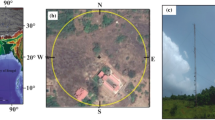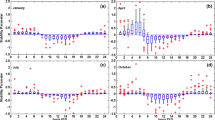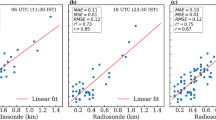Abstract
Surface to atmosphere exchange has received much attention in numerical weather prediction models. This exchange is defined by turbulent parameters such as frictional velocity, drag coefficient and heat fluxes, which have to be derived experimentally from high-frequency observations. High-frequency measurements of wind speed, air temperature and water vapour mixing ratio (eddy covariance measurements), were made during the Integrated Ground Observation Campaign (IGOC) of Cloud Aerosol Interaction and Precipitation Enhancement Experiment (CAIPEEX) at Mahabubnagar, India (16∘44′N, 77∘59′E) in the south-west monsoon season. Using these observations, an attempt was made to investigate the behaviour of the turbulent parameters, mentioned above, with respect to wind speed. We found that the surface layer stability derived from the Monin–Obukhov length scale, is well depicted by the magnitude of wind speed, i.e., the atmospheric boundary layer was under unstable regime for wind speeds >4 m s−1; under stable regime for wind speeds <2 m s−1 and under neutral regime for wind speeds in the range of 2–3 m s−1. All the three stability regimes were mixed for wind speeds 3–4 m s−1. The drag coefficient shows scatter variation with wind speed in stable as well as unstable conditions.









Similar content being viewed by others
References
Agarwal P, Yadav A K, Gulati A, Raman S, Rao S, Singh M P, Nigam S and Reddy N 1995 Surface layer turbulence processes in low wind speeds over land; Atmos. Environ. 29 2089–2098.
Chowdhuri S, Prabha T V, Karipot A, Dharamraj T and Patil M N 2015 Relationship between the momentum and scalar fluxes close to the ground during the Indian post-monsoon period; Bound.-Layer Meteorol. 154 333–348.
Clark C A and Arritt R W 1995 Numerical simulations of the effect of soil moisture and vegetation cover on the development of deep convection; J. Appl. Meteorol. 34 2029–2045.
Claus J, Krogstad P -Å and Castro Ian P 2012 Some measurements of surface drag in urban-type boundary layers at various wind angles; Bound.-Layer Meteorol. 145 407–422.
Enriquez A G and Friehe C A 1997 Bulk parameterization of momentum, heat and moisture fluxes over a coastal upwelling area; J. Geophys. Res. 102 (C3) 5781–5798.
Foken T and Wichura B 1996 Tools for quality assessment of surface-based flux measurements; Agri. Forest Meteorol. 78 83–105.
Garratt J R 1977 Review of drag coefficients over oceans and continents; Mon. Wea. Rev. 105 915–929.
Gillies J A, Nickling W G and King J 2002 Drag coefficient and plant form response to wind speed in three plant species: Burning Bush (Euonymus alatus), Colorado Blue Spruce (Picea pungens glauca.), and Fountain Grass (Pennisetum setaceum); J. Geophys. Res. 107(D24).
Ham J M and Heilman J L 2003 Experimental test of density and energy-balance corrections on carbon dioxide flux as measured using open-path eddy covariance; Agron. J. 95 1393–1403.
Krishnan P and Kunhikrishnan P K 2002 Some characteristics of atmospheric surface layer over a tropical inland region during southwest monsoon period; Atmos. Res. 62 111–124.
Kulkarni J R et al. 2012 Cloud Aerosol Interaction and Precipitation Enhancement Experiment (CAIPEEX): Overview and preliminary results; Curr. Sci. 102 413–425.
Kusuma G R. 2004 Estimation of the exchange coefficient of heat during low wind convective conditions; Bound.-Layer Meteorol. 111 247–273.
Kusuma G R., Narasimha R and Prabhu A 1996 Estimation of drag coefficient at low wind speeds over the monsoon trough land region during MONTBLEX-90; Geophys. Res. Lett. 23 2617–2620.
Lee X and Massman W J 2011 A perspective on Thirty Years of the Webb, Pearman and Leuning density corrections; Bound.-Layer Meteorol. 139 37–59.
Lee X, Massman W and Law B 2004 Handbook of Micrometeorology: A Guide for Surface Flux Measurement and Analysis; Kluwer Academic Publishers, pp. 60–61.
Leuning R and Moncrieff J 1990 Eddy covariance CO 2 flux measurements using open- and closed-path analysers: Corrections for analyser water vapour sensitivity and damping fluctuations in air sampling tubes; Bound.-Layer Meteorol. 53 63–76.
Leuning R, Denmead O T and Lang A R G 1982 Effects of heat and water vapor transport on eddy covariance measurement of CO 2 fluxes; Bound.-Layer Meteorol. 23 209–222.
Li B and Avissar R 1994 The impact of spatial variability of land-surface characteristics on land surface heat-fluxes; J. Climate 7 527–537.
Liebethal C and Foken T 2003 On the significance of the Webb correction to fluxes; Bound-Layer Meteorol. 109 99–106.
Liebethal C and Foken T 2004 On the significance of the Webb correction to fluxes: Corrigendum; Bound.-Layer Meteorol. 113 301.
Mahrt L, Vickers D, Sun J, Jensen N O, Jorgensen H, Pardyjak E and Fernando H 2001 Determination of the surface drag coefficient; Bound.-Layer Meteorol. 99 249–276.
Mahrt L, Sun J and Stauffer D 2015 Dependence of turbulent velocities on wind speed and stratification; Bound.-Layer Meteorol. 155 55–71.
Massman W J 1991 The attenuation of concentration fluctuations in turbulent-flow through a tube; J. Geophys. Res. 96D 15,269–15,273.
Mauder M and Foken T 2006 Impact of post-field data processing on eddy covariance flux estimates and energy balance closure; Meteorologische Z 15 597–609.
Miao M and Ji J 1996 Study on diurnal variation of bulk drag coefficient over different land surfaces; Meteorol. Atmos. Phys. 61 (3–4) 217–224.
Miller M J, Beljaars A C M and Palmer T N 1992 The sensitivity of the ECMWF model to the parameterization of evaporation from the tropical oceans; J. Climate 5 418–434.
Panda J and Sharan M 2012 Influence of land-surface and turbulent parameterization schemes on regional-scale boundary layer characteristics over northern India; Atmos. Res. 112 89–111.
Patil M N 2006 Aerodynamic drag coefficient and roughness length for three seasons over a tropical western Indian station; Atmos. Res. 80 280–293.
Patil M N, Waghmare R T, Halder S and Dharmaraj T 2011 Performance of Noah land surface model over the tropical semi-arid conditions in western India; Atmos. Res. 99 85–96.
Patil M N, Dharmaraj T, Waghmare R T, Prabha T V and Kulkarni J R 2014 Measurements of carbon dioxide and heat fluxes during monsoon-2011 season over rural site of India by eddy covariance technique; J. Earth Syst. Sci. 123 177–185.
Segal M and Arritt R W 1992 Non-classical mesoscale circulations caused by surface sensible heat flux gradients; Bull. Am. Meteorol. Soc. 73 1593–1604.
Suzuki N, Toba Y, Komori S, Takagaki N, Baba Y, Kubo T, Shintaku K and Yamamoto M 2014 Variation of the drag coefficient investigated by using tower-based long period measurements – condition of high wind speed with following and cross swell; Int. J. Offshore and Polar Engg. 24 (3) 168–173.
Webb E K, Pearman G I and Leuning R 1980 Correction of the flux measurements for density effects due to heat and water vapour transfer; Quart. J. Roy. Meteorol. Soc. 106 85–100.
Wen F, Gao Z, Wu Z and Lu H 2005 Wind speed scaling and the drag coefficient; Acta Oceanol. Sin. 24 (4) 29–42.
Xiao W, Liu S, Wang W, Yang D, Xu J, Cao C, Li H and Lee X 2013 Transfer coefficients of momentum, heat and water vapour in the atmospheric surface layer of a large freshwater lake; Bound.-Layer Meteorol. 148 479–494.
Zachry B C, Schroeder J L, Kennedy A B, Westerink J J and Letchford C W 2013 A case study of nearshore drag coefficient behavior during hurricane Ike (2008); J. Appl. Meteorol. Climatol. 52 2139–2146.
Zhu P and Furst J 2013 On the parameterization of surface momentum transport via drag coefficient in low-wind conditions; Geophys. Res. Lett. 40 2824–2828.
Acknowledgements
The authors express their gratitude to Dr M Rajeevan, Director, Indian Institute of Tropical Meteorology, Pune for inspiration. The CAIPEEX-IGOC program was fully funded by the Ministry of Earth Sciences, Govt. of India.
Author information
Authors and Affiliations
Corresponding author
Additional information
Corresponding editor: K Rajendran
Rights and permissions
About this article
Cite this article
Patil, M.N., Waghmare, R.T., Dharmaraj, T. et al. The influence of wind speed on surface layer stability and turbulent fluxes over southern Indian peninsula station. J Earth Syst Sci 125, 1399–1411 (2016). https://doi.org/10.1007/s12040-016-0735-5
Received:
Revised:
Accepted:
Published:
Issue Date:
DOI: https://doi.org/10.1007/s12040-016-0735-5




